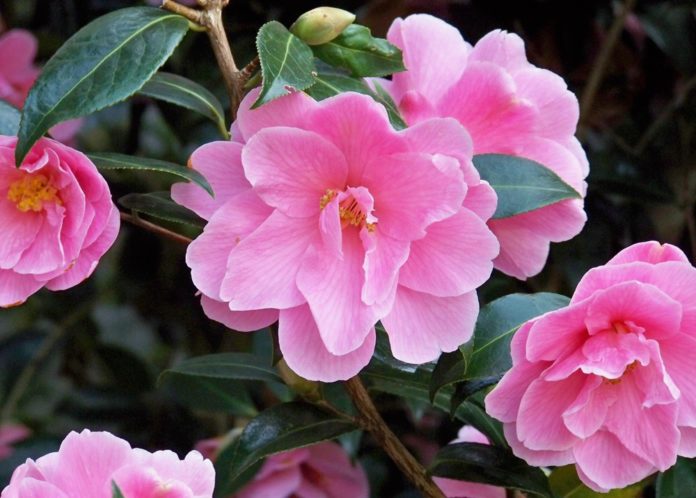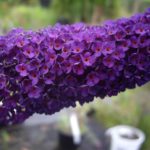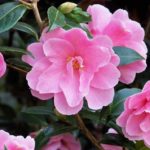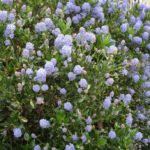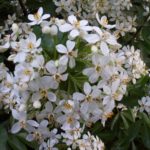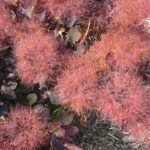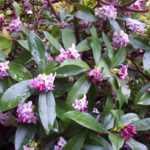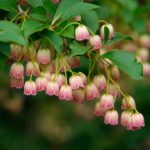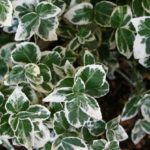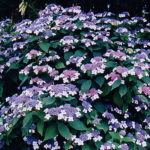1Buddleia davidii ‘Black Knight’ (butterfly bush)
Walk into any garden and most of the plants you see come from other parts of the world. Buddleia, the butterfly bush, originates from the Sichuan and Hubei areas of China. It gets its name because it has the uncanny knack of attracting butterflies. ‘Black Knight’ is one of the most beautiful and reliable cultivars. It has dark purple flowers and is disease-free and responsive to hard pruning. Other top performers are ‘Royal Red’ (purple-red), ‘Dartmoor’ (red-purple), ‘Pink Delight’ (bright pink), ‘Nanho Blue’ (bluish-mauve) and Harlequin’ (variegated leaves). Excellent whites include ‘White Cloud’, ‘Peace’, ‘White Bouquet’ and ‘White Profusion’.
2Hibiscus syriacus (Rose of Sharon)
This is a first-rate, late summer-flowering shrub worthy of having in any garden. It can grow into a substantial bush and produce lovely hollyhock-like blooms in a wide variety of colours from August to September. Native to Syria, it is perhaps most popular of all in France and Italy, where it is used extensively in parks and gardens. ‘Blue Bird’ is one of the best cultivars. It has light blue flowers with a dark centre and it has proven itself to be a reliable performer in many gardens over the years. Other top cultivars include ‘Woodbridge’ (rose-pink with carmine centre), ‘Aphrodite’ (pink with red centre), ‘Ardens’ (purple), ‘Coelestis’ (sky blue), ‘Lucy’ (bright red), ‘Blushing Bride’ (pink), ‘Morningstar’ (white), ‘Paeoniflorus’ (pink), ‘Rubis’ (red), ‘Single White’ (white) and ‘Tricolor’ (red, white and blue).
3Camellia x williamsii ‘Donation’
The man who the camellia is named after never saw one in flower. The camellia was named by 18th-century Swedish botanist Carl Linnaeus after a 17th-century Jesuit missionary and botanist he admired called George Kamel. Kamel spent most of his time documenting the plant life on the island of Luzon in the Philippines. In 18th-century England, there was some interest in camellias, mostly Camellia japonica. But the plant’s popularity really took off in the 1900s when exciting hardy varieties were developed. This happened because of the work of plant hunter George Forrest, who brought seeds of C. saluenensis to Britain. He crossed it with C. japonica to produce a wonderful new group of camellias that became known as williamsii hybrids, after J.C. Williams of Cornwall who helped fund Forrest’s plant-hunting expedition. There are many excellent hybrids of C. x williamsii, but easily the most noble and reliable is ‘Donation’. It was first introduced in 1941 and was immediately admired for its great vigour and the profusion of flowers . Other excellent williamsii hybrids to look for include ‘Jury’s Yellow’, ‘J.C. Williams’, ‘Ballet Queen’, ‘Brigadoon’, ‘Ruby Wedding’, ‘Joan Trehane’, ‘Mary Larcom’, ‘Debbie’, ‘Anticipation’ and ‘Saint Ewe’.
4Ceanothus impressus ‘Victoria’ (California lilac)
Native to California, ceanothus likes its summers warm and dry and its winter free from frost. In full bloom in late spring to early summer, the fragrant blue flowers are a glorious sight. Some kinds can be grown against a sturdy wall or against the house and allowed to billow into a great cloud of blue. Or some can be used as a low-growing, spreading groundcover. Most kinds are evergreen, although there are some that lose their leaves in cool gardens and are considered deciduous. ‘Victoria’ is an excellent choice, growing to 10 feet (3 m) and flowering profusely in early summer. It is a superior cultivar because of its attractive, compact habit and its ability to flourish in even a chilly coastal garden without showing any cold damage to its leaves. Other top hybrids include ‘Blue Mound’ and ‘Cascade’. Best of the deciduous varieties that flower later in summer are ‘Gloire de Versailles’ and ‘Topaz’, both of which sometimes put on a second flush of bloom in fall. For low-growing, carpeting types, look for ‘Blue Cushion’, ‘Hurricane Point’ and ‘Yankee Point’. Size: 6 to 10 feet (1.8 to 3 m)
5Choisya ternata (Mexican orange blossom)
Everyone agrees that Mexican orange blossom is a top-of-the-line, five-star shrub. It has handsome, glossy, evergreen foliage; a well-behaved, compact form; and attractive, fragrant clusters of white flowers in April and May. Being remarkably drought-resistant, it also performs very respectably in a container. The flowers have an orange fragrance and the plant is native to Mexico, which accounts for its common name. The leaves also give off a pleasant, fruity aroma when bruised or when the plant is trimmed. The ordinary species Choisya ternate is fine, but many prefer the variety ‘Aztec Pearl’. There is also ‘Sundance’, which has bright yellow leaves and also grows between 4 and 6 feet (1.2 to 2 m). Choisya can be used to add foliage texture and contrast to the mixed border. This is really its primary function in the garden
6Cotinus coggygria (smoke bush)
This is an attractive. foliage shrub with distinctive, plum-purple, oval-shaped leaves that are exceptional, especially when contrasted against the dark green background of a cedar or yew hedge. Native to southern Europe and eastward to China, the shrub gets its common name from its delicate feathery panicles of pinkish-purple flowers that form in summer and give the impression of puffs of smoke. Cotinus coggygria ‘Royal Purple’ will quickly soar to over 15 feet (4.5 m) if left unpruned and can achieve almost that in width. It will, however, tolerate regular pruning and can be kept down to a manageable size. Other top cultivars include ‘Flame’, which has purple-pink plumes and scarlet fall color, ‘Velvet Cloak’, which has reddish-purple leaves that turn red in fall, and ‘Grace’, which has red-purple leaves.
7Daphne odora (winter daphne)
Daphne is said to possess the world’s most powerful fragrance. The most popular variety is the February-flowering Daphne mezereum which grows to 3 or 4 feet (1 to 1.2 m) and produces highly scented purple-red flowers on bare, erect, twiggy branches. The kind I like best, however, is the winter daphne, D. odora, which has soft, slender evergreen leaves and extremely fragrant, purple-pink flowers that appear in January and February and continue on sporadically into spring. The fragrance of these exquisite blooms has been described as an ambrosia dessert laced with an orangy-coconut juice. It has the most powerful scent of all daphnes. In the summer, the shrub’s foliage maintains its bright shade of green provided it is not allowed to languish in excessively dry soil. It grows to 4 feet (1.2 m) tall and wide. There is a variegated version–Daphne odora ‘Aureomarginata’–which is slightly more cold resistant, is less prone to viral diseases, and has equally fragrant flowers. It is, however, variegated– green leaves with creamy edges–something not all gardeners like.
8Enkianthus campanulatus (pagoda bush)
Enkianthus is a great bush for the back of the mixed shrub border. It has abundant clusters of bell-shaped cream flowers with rosy-pink veins and tips in spring. The flowers have a sophisticated delicacy due to their colour, size and habit of dangling in dense clusters. In full leaf, the bush forms an attractive, structurally useful green backdrop. In autumn, the small, oval-shaped leaves turn shades of crimson, yellow and orange–as impressive as any maple. Native to the mountains of Honshu in Japan, enkianthius has tended to be shunned by professional garden-makers mainly because of its low-key flowering habit, lack of colour in summer and relaxed overall form. It is, however, a treasured shrub, valued by true plant lovers, who are more than willing to find a place for it if only for the beauty of the flowers, which you can often find decorating the covers of general gardening books and plant encyclopedias.
9Euonymus fortunes
It’s important for a garden to have good “botanical bones” – plants that provide structure year round. Perennials rise and fall, annuals come and go, but there is a special place for no-fuss plants that provide consistent and reliable colour and form. Euonymus fortunei is an especially useful and versatile plant in this category. Not only does it offer excellent foliage contrast, this popular and dependable evergreen shrub can be grown in various ways in a variety of locations. ‘Emerald Gaiety’ is an elegant choice, having crisp, grey-green and creamy white variegated foliage. A compact bush, it can be pruned for size and shape. In winter, the leaves turn a little pink, adding a touch of seasonal interest. Another popular cultivar is ‘Emerald ‘n’ Gold’ with striking bright yellow and green variegated leaves. It grows 2 to 3 feet tall (60 to 90 cm), making it suitable as a groundcover or dwarf hedge. Its foliage also gets a pinkish tinge in winter. Other top varieties include ‘Canadale Gold’ (green with gold edges), ‘Country Gold’ (green with gold edges), ‘Gold Tip’ (green with gold markings) and ‘Silver Queen’ (green leaves with white edges).
10Hydrangea serrata ‘Bluebird (lacecap hydrangea)
Considered by many to be the “queen of flowering shrubs” hydrangeas are magnificent plants, an indispensable component in a coastal garden. There are two main kinds: mopheads (also called hortensias), which have large, globular flowerheads; and lacecaps, which have slightly more decorative flower heads with dense centres skirted by a light garland of single, flat flowers. Both types are extremely popular, but lacecaps, which get their name from their resemblance to the lace caps worn by servant girls at one time in Europe, are a tad more elegant. ‘Bluebird’, which produces rich blue lacecap flowers, is a good cultivar. It is compact, growing only 4 to 6 feet (1.2 to 1.8 m). ‘Blue Wave’ is similar. Other popular cultivars are ‘Lanarth White’ and ‘Seafoam’. Mophead hydrangeas – mostly cultivars of H. macrophylla – are also much loved for their tight, ball-shaped flower heads. Look for ‘Nikko Blue’, ‘Teller’s Blue’ (a.k.a. ‘Blue Tit’ and ‘Blue Sky’), ‘Merritt’s Beauty’, ‘Altona’, ‘Hamburg’, ‘Europa’ and ‘Merritt’s Supreme’.
